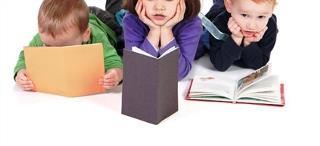
Telling and Retelling Stories: Learning Language and Literacy
Young children are active participants in buildinglanguage and literacy skills. They learn asthey participate in meaningful experiences andinteract with children and adults, constructinglanguage during the process. Much of thelanguage children learn reflects the language andbehavior of the adult models they interact withand listen to (Strickland & Morrow 1989). Adults scaffoldchildren’s language learning by providing a model that isexpressive, responsive, and enjoyable.One way to enrich children’s language experienceis through the use of storytelling. Many studies haveshown that children build vocabulary, use more complexsentences, and improve comprehension whenfrequently exposed to stories. Egan (1986) explains thatwe remember best in story form; he supports the use ofstories as a way of organizing curriculum for children.The magnetic quality of the story is the universal powerto remember, entertain, teach, inspire, create, and know(Raines & Isbell 1994).Comparing reading aloud and telling storiesReading aloud and telling stories are both effectiveways to share literature with young children and to supportlanguage and literacy learning. But while story readingfrequently occurs in early childhood settings and isvalued as an important tool to enhance literacy development,storytelling is frequently viewed as a frill and onlyoccasionally used in classrooms (Cooter 1991). Mallan(1996) explains that the story and storytelling are essentialto human existence. The story told has distinctivecharacteristics that make it an excellent techniqueto foster oral language development and provide a richfoundation for literacy.The experience of hearing a story told is more personaland connected to the listener. The storyteller canmaintain eye contact and adapt the telling of the storyto specificlisteners; a story reader usually follows thetext exactly and focuses her eyes on the words on thepage. The language of storytelling is often more informalthan printed text. Listeners, regardless of theirlanguage skills or reading abilities, can understand thestory because it is communicated through words, vocalintonation, gestures, facial expressions, and bodymovement (Mallan 1997). For these reasons, storytellingconnects to the language of the children and therebyhas the potential for increasing their understandingof the story.Storytelling promotes expressive language development—in oral and written forms—and presents newvocabulary and complex language in a powerful formthat inspires children to emulate the model they haveexperienced. Stauffer (1980) says that the function oflanguage is to communicate, and communication is themain purpose of language. In the personal setting ofthe storytelling environment, the storyteller’s languageand the story together establish a rapport that encour-ages children to connect to the story using their ownlanguage and experiences. The storytelling experienceassists children in generating stories and encouragestheir dictation and story writing (Nelson 1989).
[...] As children become more confident in their oralabilities and understanding of stories, they will wantto select new stories for telling. In addition to storiesabout things they have experienced and the people intheir lives, children can use story collections and newbooks to expand their repertoire.Young children create visual images and use theirimagination to determine the story setting, characters,and happenings. The story becomespersonally meaningful to thembecause they have been involvedin the process. Children who areemotionally connected to theirstories become motivated to masterthe goals of emergent literacy. Theyhave the desire to communicate bothorally and in written form. In thisway, they share and preserve theirstories to revisit (Brand, Trostle, &Donato 2001).Young writers often draw their stories.The storyteller is both authorand illustrator (Gillard 1996). Other children who dictatethe events to a teacher later draw, scribble, or produceletters on the transcription. A familiar story serves as abeginning framework for writing of stories and for lateroriginal creations. Stories told include descriptionsof the setting, detailed information about the appearanceof the characters, and a clear sequence of action.These add enriched language that can be reused andvariety in the rewriting of the story. Because stories toldfrequently include a narrative, children also use thismore advanced element in the telling and writing of theirstories (McGee & Richgels 2000).Αs children begin to communicate their stories orally,they want to record their treasures, dictating to theteacher or writing independently. They can read thewritten versions to a friend or take them home to sharewith families. The oral transcript consists of the wordsthe children used in their telling, which makes the storyan easy text to read. A collection of stories told in aclassroom and transcribed is a wonderful addition tothe literacy center, where children can “read,” enjoy,Jerome is talking with a friend in the library area of hiskindergarten classroom. He begins, “I am going to tell youa story… Once upon a time, there was an old man wholived in a shabby house on a high, high hill. One day hewalked to the market to buy a fish for dinner. He picked outan enormous grayfish and put it in his basket. On the wayhome the enormousgrayfish jumped out of his basket andjumped into a river and swam away. So the sad old manwent home with no money and no fish. His wife was notvery happy with him. She told him that if the fish jumpedinto the river it must be magic. She told him to go back tothe river and ask the magic fish for a new house with tworooms. And he did.”This is the beginning of a very complicated storytellingby a five-year-old boy. His story continued until the entireJerome’s Storysequence, including five requests to the magic fish, wererelated to his attentive friend. He even included the moral,“The man went home and found a shabby hut—becausehe asked for too much.”Jerome’s complete story is over 500 words—a very fluentretelling that clearly demonstrates hisdesire to communicatehis ideas. He included many of the conventions ofstory that he had experienced when his teacher told “TheMagic Fish.” Last week Jerome heard the story for the firsttime and this week it was retold. Today, Jerome becamethe teller of the folktale, and soon he will be telling and writingown stories.
[Πηγές πληροφόρησης:http://www.naeyc.org/yc/files/yc/file/200203/Isbell_article_March_2002.pdf ]
Ημερομηνία πρόσβασης: 27 Ιανουαρίου 2017
